Coffee Drinks
Iced Coffee Vs. Hot Coffee: How Do These Coffees Differ?
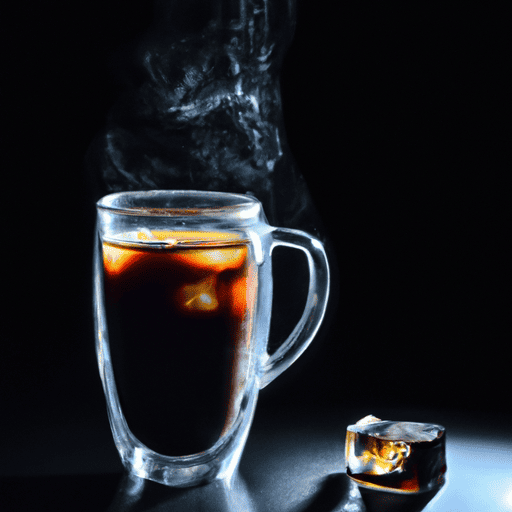
As a coffee lover, I often find myself wondering about the differences between iced and hot coffee. Both are popular beverages that offer unique experiences, but what sets them apart?
In this article, I will explore the brewing techniques, temperature differences, serving styles, caffeine content, flavor profiles, preparation time, accessibility, environmental impact and popular variations of iced coffee and hot coffee.
Firstly, the brewing techniques for these two coffees are quite distinct. While hot coffee is brewed using hot water and is typically served immediately after being made or kept warm on a burner or in a carafe. On the other hand, Iced Coffee requires either cold brewing or flash-chilling to ensure that it retains its flavor without becoming too bitter or diluted by melting ice cubes.
Moreover, Iced Coffee can be made using different kinds of beans than those used for Hot Coffee to bring out different flavors as well as aroma characteristics. Understanding these fundamental distinctions between these two types of coffees is important because they affect not only the taste but also how each type of coffee is prepared and served.
Key Takeaways
- Temperature plays a crucial role in determining the taste and texture of coffee, with different temperatures creating vastly different flavor profiles.
- Texture is a crucial element that sets apart the drinking experience of hot and iced coffee, with hot coffee having a smooth and creamy consistency due to its high temperature while iced coffee has a thinner and more watery texture.
- Cold brew and flash-chilled methods for iced coffee produce a smoother and less acidic taste while maintaining delicate flavor notes.
- Sustainability should be considered when choosing between iced and hot coffee, as iced coffee requires more energy to produce and transport and often results in more waste from packaging materials.
Brewing Techniques
You’ll need to adjust your brewing techniques when making iced coffee, but it’s worth it for the refreshing and smooth taste that results.
One popular method is using a French press. Simply add coarsely ground coffee beans to the press, pour in cold water, and let it steep in the refrigerator overnight. The next morning, plunge the filter down and pour over ice for a quick and easy iced coffee.
Another option is using a pour over technique. While this may take a bit longer than the French press method, it produces a clean and crisp flavor profile. Start by placing ice in your glass or carafe before brewing directly onto it with hot water. This will immediately chill the coffee as it drips through the filter.
When discussing brewing techniques for iced coffee vs hot coffee, temperature differences are an important consideration. While hot coffee requires high temperatures to extract maximum flavor from beans, this can lead to bitterness when brewed cold. In contrast, iced coffee should be brewed at lower temperatures to avoid any harsh flavors or off-notes in the final product.
Temperature Differences
When it comes to brewing coffee, temperature plays a crucial role in determining the taste and texture of your cup. As a barista, I’ve learned that different temperatures create vastly different flavor profiles. For example, hotter water can result in a more bitter taste.
Additionally, the texture of coffee can be affected by temperature as well. Colder temperatures often result in a smoother mouthfeel.
How Temperature Affects Taste
Interestingly enough, the temperature of your coffee can significantly impact its flavor profile. The degree to which you enjoy a hot or cold cup of coffee may vary based on your individual taste buds and preferences, but there are a few general observations that can be made about how temperature affects taste.
Here are four key things to keep in mind:
- Hot coffee tends to have a more prominent aroma than iced coffee.
- Cold temperatures can dull flavors and make them less noticeable.
- High temperatures can also mute certain flavors, while bringing out others.
- Your perception of sweetness and bitterness can change depending on the temperature of your coffee.
All of these factors contribute to the unique sensory experiences associated with different types of coffee drinks. As we explore texture differences in the next section, it’ll become clear that temperature is just one aspect among many that make hot and iced coffees distinct from one another.
Texture Differences
Texture is a crucial element that sets apart the drinking experience of hot and iced coffee. The temperature of the coffee affects its texture, which in turn impacts the flavor profile.
Hot coffee has a smooth and creamy consistency due to its high temperature, whereas iced coffee has a thinner and more watery texture. Apart from temperature, brewing method also contributes to the texture differences between hot and iced coffee.
Hot coffee is typically brewed using methods such as drip or French press, which result in higher extraction rates and stronger flavors. On the other hand, iced coffee is often brewed using cold brew or flash-chilled methods, which produce a smoother and less acidic taste while maintaining its delicate flavor notes.
As we move on to discussing serving styles in relation to these two types of coffees, it’s important to note how their textures play an integral role in determining how they are best served.
Serving Styles
When it comes to serving styles for coffee, there are several key points to consider. Firstly, the addition of cream and sugar can greatly impact the taste and texture of the beverage.
Secondly, milk and flavorings such as syrups or spices can add depth and complexity to a cup of coffee.
Lastly, ice and garnishes like whipped cream or chocolate shavings can elevate the presentation of a drink.
As someone who’s worked in the coffee industry for years, I’ve seen firsthand how these elements can transform a simple cup of joe into an artful masterpiece.
Cream and Sugar
Adding cream and sugar can turn a bitter cup of coffee into a sweet treat, but as a coffee lover, I’ve come across different cream alternatives and sweeteners that enhance my coffee drinking experience.
One popular cream alternative is almond milk which adds nutty flavors to the brew, while coconut milk provides a creamy texture with hints of coconut flavor. For those who prefer something sweeter, honey or maple syrup are great natural sweeteners that complement the coffee’s taste profile without overpowering it.
However, some people enjoy their coffee black to fully savor its unique flavor notes. Black coffee has no added calories or artificial flavors, making it an ideal choice for health-conscious individuals.
But if you’re like me who likes to experiment with different tastes and textures in their morning cup of joe, then adding milk and flavorings like cinnamon or vanilla could be worth exploring.
Milk and Flavorings
If you really want to take your coffee game to the next level, you should definitely consider trying different milk alternatives and flavorings. Dairy-free options like almond milk or oat milk can add a nutty or creamy taste to your coffee that complements its rich aroma. Soy milk is also a popular choice for those who prefer a plant-based diet.
Moreover, flavored syrups like vanilla, caramel, and hazelnut can enhance the sweetness of your drink and create a unique flavor profile that matches your preferences. Another way to elevate your coffee experience is by adding foam art on top of your latte or cappuccino.
This technique involves steaming the milk until it becomes frothy and pouring it into the espresso shot in such a way that creates patterns and designs on the surface. From hearts and flowers to animals and landscapes, there are endless possibilities for you to express your creativity with foam art.
Not only does it make your drink more visually appealing, but it also adds texture and depth to the overall taste of the coffee. With these tips in mind, let’s move on to explore how ice and garnishes affect our choice between iced coffee vs. hot coffee.
Ice and Garnishes
Now that we’ve talked about the many milk and flavoring options available for both iced and hot coffee, let’s move on to discussing ice and garnishes.
The most obvious difference between the two types of coffee is, of course, temperature. While hot coffee is served steaming and fresh from the pot, iced coffee is brewed before being chilled in a refrigerator or over ice cubes.
However, not all coffee drinkers enjoy having their iced drinks diluted by melting ice cubes. Luckily, there are plenty of alternatives to traditional ice cubes that can be used instead. One popular option is to freeze brewed coffee into small cubes ahead of time so that they can be added to an iced drink without watering it down. Other alternatives include using frozen fruit such as berries or grapes as a way to keep your drink cool while adding a burst of flavor.
In terms of garnishes, iced coffee often comes with whipped cream or flavored syrups such as vanilla or caramel drizzle on top for added sweetness. It’s important to note that while some garnishes may add extra calories and sugar to your cup, others like cinnamon or cocoa powder can provide health benefits such as anti-inflammatory properties and antioxidants.
Moving forward into our discussion about caffeine content in hot versus iced coffee, it’s worth noting that this factor plays a significant role in differentiating the two beverages beyond simply temperature and additives.
Caffeine Content
You’ll be happy to know that iced coffee typically has the same amount of caffeine as hot coffee, so you can switch things up without sacrificing your morning boost. However, it’s important to keep in mind that caffeine sensitivity varies from person to person and some may experience different effects depending on the type of coffee they consume. It’s always best to listen to your body and adjust accordingly.
In terms of health benefits, both hot and iced coffee contain antioxidants which have been linked to reducing the risk of certain diseases such as cancer and Parkinson’s disease. Additionally, studies have shown that moderate coffee consumption can improve cognitive function and decrease the risk of depression.
To help illustrate the caffeine content difference between various types of coffees, here is a table comparing the average amount of caffeine found in popular drinks:
| Drink Type | Caffeine Content (mg) |
|---|---|
| Drip Coffee | 95 |
| Espresso | 63 |
| Iced Coffee | 95 |
| Cold Brew | 200 |
| Latte | 77-150 |
As you can see, cold brew contains significantly more caffeine than other types of coffee due to its steeping process. This information can come in handy when deciding which type of coffee will give you the right amount of energy for your day.
Moving onto flavor profiles, while both hot and iced coffees contain similar amounts of caffeine, their taste can differ greatly due to factors such as brewing method and temperature. Let’s take a closer look at these differences in the next section.
Flavor Profiles
Get ready to savor the nuances of your favorite caffeine fix as we explore the unique flavor profiles found in iced and hot coffee. The flavor profile of a cup of coffee is influenced by various factors, including brewing methods and roast types.
When it comes to brewing methods, iced coffee is typically brewed using a cold brew method, which results in a smoother taste with less acidity compared to hot brewed coffee. Roast types also play an essential role in determining the flavor profile of your coffee.
Lighter roasts tend to be more acidic and fruity, while darker roasts have a bold, smoky flavor with hints of chocolate or caramel. Iced coffee often uses medium or dark roasted beans because they hold up well against ice and milk without losing their characteristic flavors. The difference in brewing methods and roast types between iced and hot coffee leads to distinct flavor profiles.
However, both forms offer delicious variations that can satisfy different preferences depending on what you’re looking for. Speaking of different preferences, let’s move on to discussing how the preparation time affects our choice between iced or hot coffee!
Preparation Time
When it comes to preparing coffee, the time required can vary greatly depending on the method used. As someone who’s spent years experimenting with different brewing methods, I’ve found that hot coffee typically takes the shortest amount of time to prepare. It simply involves pouring hot water over ground beans.
On the other hand, iced coffee and cold brew require more time and patience. Iced coffee is made by cooling hot coffee down with ice. Cold brew involves steeping coarsely-ground beans in cold water overnight.
Hot Coffee
Although hot coffee is a staple morning beverage, its taste and aroma can vary greatly depending on the brewing method and quality of beans used. The flavor notes in hot coffee can range from nutty to fruity to earthy, depending on the roasting techniques employed by the coffee roaster. Generally speaking, light roasts tend to have more floral and fruity flavors while darker roasts tend towards chocolatey and nutty notes.
To better understand these differences, let’s take a look at the following table:
| Roast Level | Flavor Notes | Brewing Method |
|---|---|---|
| Light | Floral, Fruity | Pour Over |
| Medium | Nutty, Chocolatey | French Press |
| Dark | Smoky, Earthy | Espresso |
As you can see from this table, different brewing methods also affect the final flavor profile of hot coffee. For example, pour over tends to bring out more floral and fruity flavors while French press emphasizes nutty and chocolatey notes. Similarly, espresso made with dark roast beans will produce a smoky and earthy taste.
Moving on to iced coffee…
Iced Coffee
One surprising fact is that Americans consume 450 million cups of iced coffee each year. Iced coffee has gained popularity in recent years, especially during the summer months when people want a refreshing beverage to cool down. The brewing methods for iced coffee differ from hot coffee as it requires more ice and less water to prevent the dilution of flavor.
Here are three types of brewing methods used for making iced coffee:
- Cold brew: This method involves steeping coarsely ground coffee in cold water overnight and then straining it to remove any sediment before serving.
- Japanese-style iced coffee: It involves using hot water to extract flavor from freshly brewed coffee and then pouring it over ice to cool down quickly.
- Flash-brewed iced coffee: This method uses a Chemex or V60 pour-over device where hot water is poured over ice cubes, directly cooling the brewed coffee.
Iced coffee also has cultural significance in many countries around the world. In Japan, for example, it’s commonly served with sweetened condensed milk and called ‘mizudashi.’ Similarly, in Vietnam, they have a popular variation called ‘ca phe sua da,’ which is made by adding sweetened condensed milk to strong Vietnamese-style drip-brewed coffee and served over ice.
Moving on to cold brew…
Cold Brew
Iced coffee has become an increasingly popular choice for many coffee drinkers, especially during the hot summer months. There are different variations of iced coffee drinks, but one that has been gaining popularity is cold brew.
Cold brew is made by steeping coarsely ground coffee beans in cold water for an extended period, usually overnight. The resulting liquid is then strained and can be served over ice or mixed with milk and sweeteners to create a refreshing drink.
One of the benefits of cold brew is that it has a smoother taste compared to traditional iced coffee because it’s less acidic and bitter due to the slow extraction process. Additionally, cold brew is said to contain more caffeine than regular coffee because it’s brewed with a higher ratio of beans to water.
Despite being a relatively new addition to the coffee world, cold brew has quickly gained popularity among consumers looking for a refreshing alternative to hot coffee or traditional iced drinks. As more people discover the benefits of cold brew, cafes and restaurants have started offering this type of beverage on their menus alongside other popular iced coffee drinks such as lattes and frappuccinos.
However, while some establishments offer ready-made bottles or cans of cold-brewed products, accessibility may still be limited in certain areas where demand isn’t as high.
Accessibility
You can easily order a hot coffee almost anywhere, making it a more accessible option than iced coffee. Coffee shops are ubiquitous and offer a variety of hot coffee options, from drip to espresso-based drinks. Additionally, many workplaces and homes have access to hot water dispensers or coffee makers, making it easy to brew a cup of hot coffee at any time.
Packaging options also contribute to the accessibility of hot coffee. Ground coffee beans come in various sizes and packaging types, including cans, bags, and single-serve pods. These options make it easy for consumers to purchase and store their preferred type of coffee without worrying about spoilage or waste.
However, accessibility does not necessarily equate to sustainability. The environmental impact of producing and consuming hot coffee is significant and should be considered when choosing between iced or hot beverages.
Transitioning into the next section on environmental impact: While accessibility is important when considering our daily caffeine fix, we must also consider the impact our choices have on the environment.
Environmental Impact
When it comes to our daily caffeine fix, it’s important to consider the environmental impact of our choices.
While both iced coffee and hot coffee have their own unique benefits, they also differ in terms of their carbon footprint. Hot coffee typically requires more energy to brew and maintain its temperature, leading to a higher carbon footprint overall. On the other hand, iced coffee can require more packaging materials and transportation due to the need for ice and additional ingredients.
However, many coffee companies are making sustainability efforts in order to reduce their environmental impact. Some businesses are implementing practices such as using renewable energy sources or reducing packaging waste. Additionally, some cafes offer incentives for customers who bring reusable cups or containers instead of relying on disposable options.
Overall, while there may be differences in the environmental impact of iced versus hot coffee, there are ways that we can all make conscious choices when it comes to our caffeine consumption. By supporting companies that prioritize sustainability efforts and bringing our own reusable containers when possible, we can help reduce our individual carbon footprints.
As we move into discussing popular variations of these coffees, it’s important to note how these variations may also affect their environmental impact.
Popular Variations
Get ready to discover some of the most popular variations of your favorite caffeinated beverage! Coffee shops are constantly coming up with new and exciting ways to serve both iced and hot coffee.
One popular trend in recent years has been adding flavors such as caramel or hazelnut syrup, which can be added to both hot and iced coffee. These syrups not only add a delicious taste but also make for a beautiful presentation.
Another popular variation is seasonal drinks. During autumn, pumpkin spice lattes dominate menus while peppermint mochas take over during winter months. In summer, you might see more fruit-inspired drinks such as raspberry or peach flavored coffees. These seasonal variations keep things interesting for customers who want to try something new each time they visit their local coffee shop.
Lastly, iced coffee lovers have another option when it comes to popular variations: cold brew. Unlike regular iced coffee, cold brew is made by steeping coarsely ground beans in water for an extended period of time before being served over ice. This process results in a smoother and less acidic flavor that many people prefer over traditional iced coffee. Cold brew has become increasingly popular in recent years due to its unique taste and high caffeine content.
There are many different ways to enjoy both hot and iced coffee thanks to coffee shop trends and seasonal variations. From flavored syrups in traditional hot or iced drinks to unique cold brew creations, there’s always something new and exciting waiting for you at your local cafe!
Frequently Asked Questions
Are there any health benefits to drinking iced coffee versus hot coffee?
When comparing iced coffee and hot coffee, there isn’t a significant difference in nutritional value or caffeine content. However, the temperature of the drink can have effects on digestion and hydration levels.
Hot coffee can stimulate digestion due to its warmth, while iced coffee may be more hydrating due to its cooler temperature. It’s important to note that any potential health benefits from either type of coffee are heavily dependent on how the drink is prepared and consumed – adding excessive amounts of sugar or cream can negate any positive effects.
Overall, it’s important to consume both types of coffee in moderation as part of a balanced diet for optimal health.
How do the prices of iced coffee and hot coffee compare?
Iced vs. Hot Coffee Prices: A Cost Comparison reveals that iced coffee is often more expensive than hot coffee due to the extra production costs associated with creating a cold beverage.
In addition, many coffee shops use premium beans or blends for their iced coffees, which can further drive up the price.
However, some coffee shops may offer discounts on iced coffees during certain times of day or promotional periods.
Overall, it’s important to keep in mind that prices can vary depending on location and brand, so it’s always a good idea to compare prices before making a purchase decision.
Can you use the same type of coffee beans for both iced and hot coffee?
When it comes to making iced coffee versus hot coffee, it is recommended to use different roasts. For instance, a lighter roast may be better for cold brew or iced coffee as the flavors come out differently than with hot brewing methods.
The best brewing method for iced coffee involves steeping coarse-grind coffee in cold water overnight and then filtering it before serving. On the other hand, hot coffee requires a finer grind and hotter water temperatures to extract the desired flavors and aromas.
While you can technically use any type of coffee beans for both iced and hot coffee, experimenting with different roasts and brewing methods can lead to a more enjoyable cup of joe.
Is it possible to make iced coffee using a French press or other non-traditional brewing methods?
When it comes to making iced coffee, traditional brewing methods such as drip or pour-over may not be the only way. In fact, I’ve found that using a French press can produce some of the best iced coffee I’ve ever had.
The key is to use coarsely ground beans and cold water, and let it steep for at least 12 hours in the fridge before plunging. While this may seem like an unconventional method, it allows for a smooth and flavorful coffee concentrate that can be diluted with ice or water to your desired strength.
Other unconventional brewing methods for iced coffee include cold brew towers or immersion brewers. These techniques all aim to extract the flavor compounds from the beans without any heat involved.
So if you’re looking for a new and exciting way to make iced coffee, give one of these non-traditional methods a try!
Are there any cultural or regional differences in the popularity of iced coffee versus hot coffee?
Cultural preferences and regional variations in the popularity of iced coffee versus hot coffee are significant.
In some regions where it’s warm or hot, such as parts of Asia, Africa, and Latin America, iced coffee is the norm. It’s often prepared with sweetened condensed milk and served over ice for a refreshing drink during hot weather.
However, in colder regions like Scandinavia or Canada, hot coffee is more popular year-round.
Cultural preferences also play a role in the popularity of these beverages. For instance, in Japan, there’s a strong preference for iced coffee as it’s seen as more refreshing and less bitter than hot coffee.
On the other hand, Southern Europe has a strong tradition of drinking espresso-based drinks served hot throughout the day.
Overall, cultural preferences and regional variations greatly influence the popularity of iced versus hot coffee around the world.
Conclusion
In conclusion, while both iced coffee and hot coffee are beloved beverages around the world, they have distinct differences in brewing techniques, temperature, serving styles, caffeine content, flavor profiles, preparation time, accessibility, environmental impact, and popular variations.
Iced coffee is brewed cold with ice while hot coffee is brewed with hot water. The temperature of these two coffees also varies greatly as one is served cold while the other is served hot.
Moreover, each type of coffee has its own unique flavor profile that appeals to different palates. While some prefer the bold taste of a hot cup of joe, others may prefer the smoother and sweeter taste of an iced latte.
However you choose to enjoy your coffee though, remember that every cup has an environmental impact, so it’s important to be mindful of your consumption habits. As the saying goes, "Every drop counts."So whether you’re a die-hard fan of iced or hot coffee, make sure to savor every sip as if it were your last—after all, life is too short for bad coffee!
Arf, an author and an innovative enthusiast of coffee, coffee alternatives, and tea, plays a crucial role as a contributor to the esteemed Cappuccino Oracle platform. Renowned for his curiosity and passion for these captivating beverages, Arf has carved out a unique space for himself in the world of exploration and writing. He realized that coffee, coffee alternatives, and tea are not mere drinks to keep one awake, but universes of flavors and stories waiting to be explored.
Arf’s articles for Cappuccino Oracle blend meticulous research with personal experiences, providing readers with an in-depth understanding of various types of coffee, coffee alternatives, and tea, along with their unique characteristics, cultures, and histories. His honest reviews and engaging narratives guide readers on their own journeys, helping them discover their preferences and find their perfect brew.
Americano
How Many Espresso Shots in a Cafe Americano
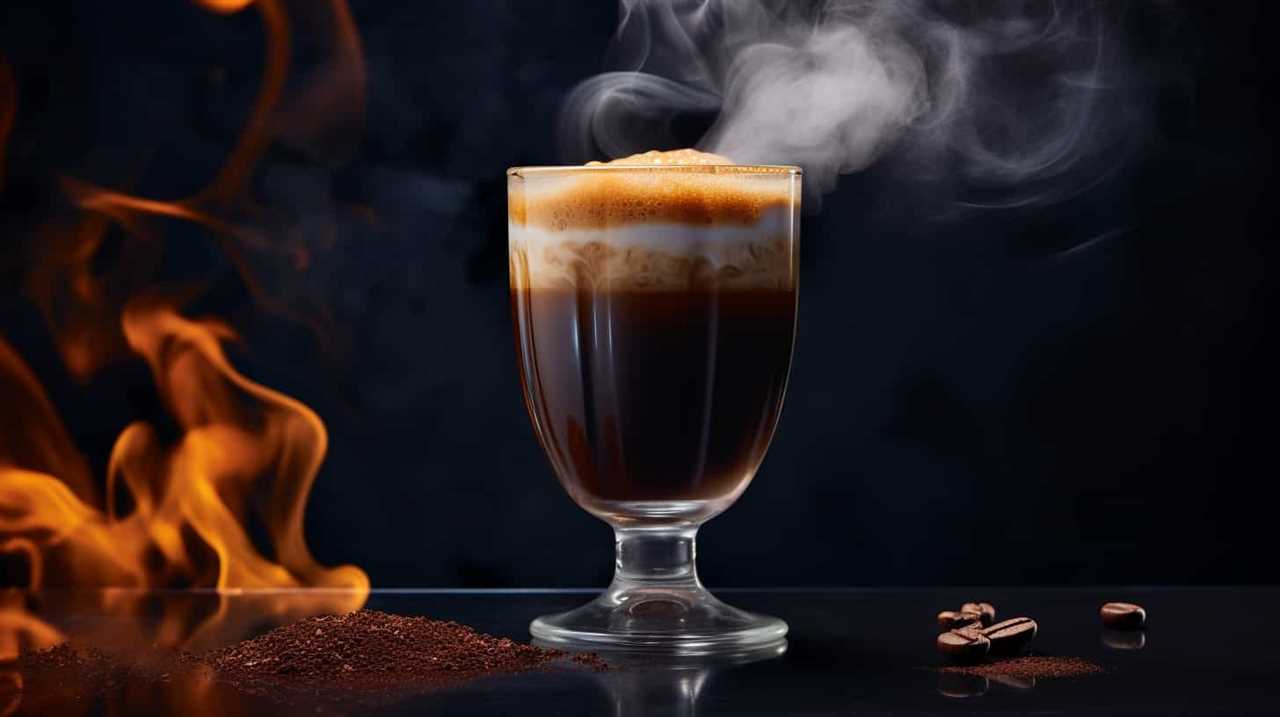
Ever thought about how many shots of espresso go into a cafe Americano? You’re in for a surprise, we have the answer ready for you! Curious to find out? Join us on this coffee adventure to unveil the secret behind this delicious drink that many coffee lovers enjoy. Let’s dive in and discover the magic of a cafe Americano together! Get ready to be amazed by what you’ll learn as we uncover the mystery behind this popular drink. Get your coffee cups ready, this will be an exciting journey you won’t want to miss!
As coffee enthusiasts ourselves, we have delved into the intricacies of this popular beverage to uncover the secrets behind its perfect balance of strength and flavor.
In this article, we will explore the factors that determine the number of shots in a cafe Americano, providing you with the knowledge to brew your own delectable cup.
So, let’s dive in and discover the art of crafting the ideal cafe Americano together.

Key Takeaways
- Cafe Americano originated during World War II when American soldiers in Italy found espresso too strong for their liking.
- The espresso-to-water ratio in a Cafe Americano is typically one part espresso to two parts water.
- The number of shots in a Cafe Americano can vary based on individual taste preferences and factors such as coffee extraction and personal preference.
- Different variations of Cafe Americano can be created by adjusting the coffee extraction and brewing techniques, allowing for customization according to personal preferences.
The Origins of Cafe Americano
We love learning about the origins of our favorite caffeinated drink, the Cafe Americano.
The historical significance of the Cafe Americano dates back to World War II, when American soldiers stationed in Italy found the local espresso too strong for their liking. To dilute the intensity, they began adding hot water to their espresso shots, creating a milder and larger beverage known as the Cafe Americano.
This cultural influence of American soldiers adapting the traditional Italian espresso demonstrates the ingenuity and adaptability of coffee culture.
Over time, the Cafe Americano has become a beloved drink both in Italy and around the world, symbolizing the blending of cultures and the appreciation for different coffee traditions.

Its popularity continues to grow, as coffee enthusiasts seek a smooth and flavorful alternative to traditional espresso.
Understanding the Espresso-to-Water Ratio
The article explains the importance of the espresso-to-water ratio in achieving the perfect balance of flavor in a Cafe Americano. Understanding this ratio is crucial for brewing techniques and coffee bean selection.
When it comes to making a Cafe Americano, the espresso-to-water ratio is key to creating the desired taste profile. The ratio typically used is one part espresso to two parts water. This ensures that the espresso is diluted enough to create a smooth and mellow flavor, while still maintaining the richness and intensity of the espresso.
However, some individuals may prefer a stronger or weaker taste, which can be achieved by adjusting the ratio accordingly. It’s important to note that experimenting with different ratios can lead to a more personalized and enjoyable Cafe Americano experience.

Factors That Influence the Number of Shots
There are several factors that can influence the number of shots needed to make a Cafe Americano.
When it comes to brewing techniques, the way espresso is extracted plays a crucial role. The grind size, water temperature, and pressure can affect the strength and volume of the shot.
Additionally, the quality of the espresso beans is essential. Beans that are freshly roasted and ground will yield a more flavorful and aromatic shot. The type of roast, such as light, medium, or dark, can also impact the intensity of the coffee.
Lastly, personal preference plays a significant role. Some individuals prefer a stronger flavor and may opt for an extra shot, while others may prefer a milder taste.

Popular Variations of Cafe Americano
Sometimes, people like to experiment with different variations of Cafe Americano to suit their taste preferences.
When it comes to popular variations of Cafe Americano, there are a few key factors to consider: coffee extraction and brewing techniques.
Coffee extraction refers to the process of extracting flavor and aroma from coffee grounds using hot water. Different brewing techniques can affect the strength and taste of the coffee.
For example, some people prefer a stronger Americano with a higher coffee-to-water ratio, achieved by using more espresso shots. Others may opt for a milder version by using fewer shots or adding extra hot water.

Additionally, some variations may include milk or sweeteners for added flavor.
Ultimately, the variations of Cafe Americano are endless, allowing individuals to customize their drink according to their preferences.
Tips for Brewing the Perfect Cafe Americano
While brewing the perfect Cafe Americano, we can follow these tips to ensure a delicious and satisfying cup of coffee:
-
Choose the right coffee beans: Opt for a medium to dark roast with a balanced flavor profile. Arabica beans are commonly preferred for their smoothness and complexity.

-
Grind your beans correctly: Aim for a medium-coarse grind to allow for proper extraction without bitterness or over-extraction.
-
Use the right water temperature: The ideal water temperature for brewing Cafe Americano is between 195°F and 205°F (90°C and 96°C) to extract the flavors properly.
-
Maintain the right coffee-to-water ratio: A standard ratio is 1:16, which means using 1 ounce of coffee for every 16 ounces of water. Adjust according to your taste preferences.
-
Master brewing techniques: Ensure proper water distribution, use a slow and steady pour, and control the brewing time to achieve a well-balanced cup of Cafe Americano.
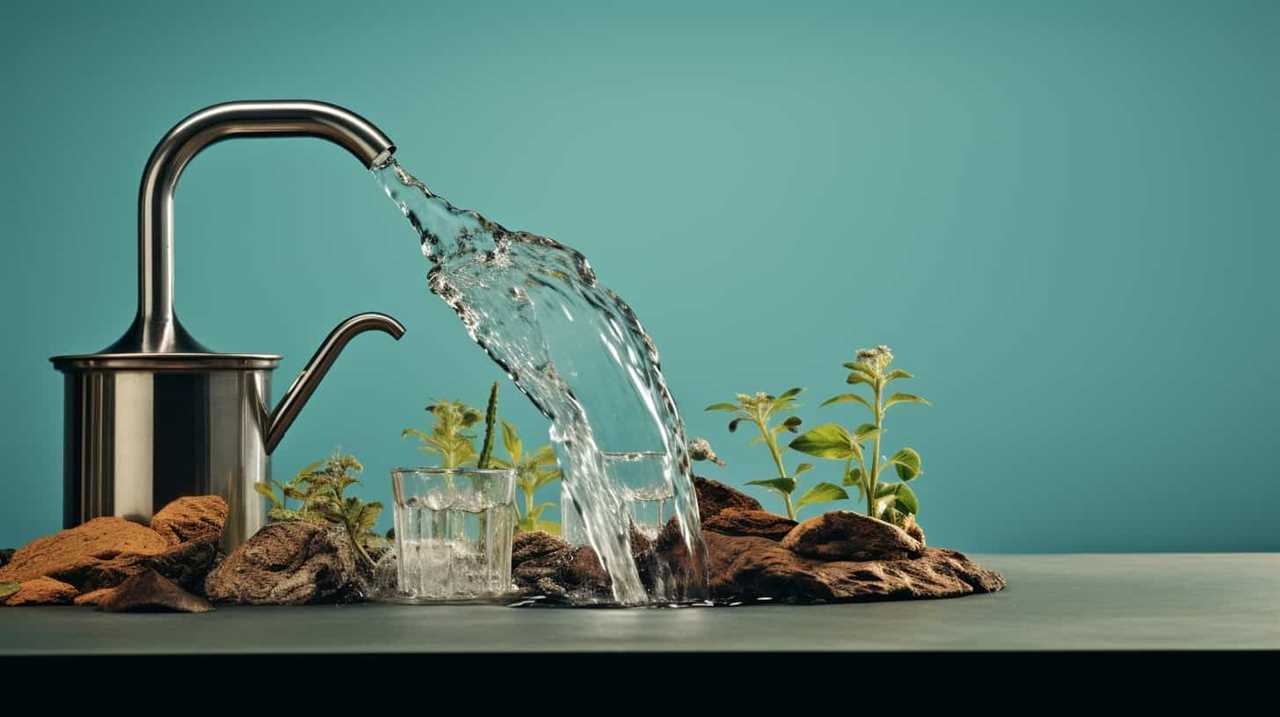
Frequently Asked Questions
How Many Calories Are in a Cafe Americano?
In a cafe americano, the number of calories can vary depending on the size and any additional ingredients. However, it is generally a low-calorie beverage. Additionally, drinking cafe americano has health benefits such as increased alertness and improved cognitive function.
Can I Make a Cafe Americano With Decaf Espresso?
Decaf espresso alternatives can be used to make a cafe americano. However, it may impact the taste and flavor. We suggest experimenting to find the right balance that suits your preferences.
What Is the Caffeine Content of a Cafe Americano?
A cafe americano can provide various health benefits, but its caffeine content can have different effects on the body. It’s important to understand the potential impact of caffeine consumption for overall wellness.
Can I Add Milk or Sugar to a Cafe Americano?
Yes, you can add milk or sugar to a cafe americano. Adding flavors is a personal preference that can enhance the taste. To make a homemade cafe americano, simply add hot water to a shot of espresso.

How Long Does It Take to Brew a Cafe Americano?
When it comes to brewing a Cafe Americano, the brewing time can vary depending on the brewing methods used. It’s important to consider the desired strength and flavor profile before starting the brewing process.
Conclusion
In the swirling depths of a perfect Cafe Americano lies the alchemy of espresso and water. With a precise understanding of the espresso-to-water ratio, the number of shots can be tailored to suit one’s taste. Factors such as bean quality, grind size, and water temperature also play a role in crafting the ideal cup.
From classic variations to inventive twists, the possibilities are endless. With a few expert tips, anyone can unlock the hidden secrets of brewing the perfect Cafe Americano. Embrace the art and science, and let your taste buds embark on a journey of rich flavors and aromatic delight.
In the vast and diverse world of coffee, coffee alternatives, and tea, Olivia has found her calling. As an author and a dedicated coffee and tea aficionado, her work for Cappuccino Oracle reflects her profound love and understanding of the intricate complexities found within these beverages. Olivia’s passion for the subject serves as both a catalyst for her creativity and a connection point with her audience.
Olivia’s appreciation for coffee, coffee alternatives, and tea blossomed at an early age. She discovered that these beverages invigorated her senses and stimulated her creative spirit. From the nuanced flavors of single-origin roasts to the captivating narratives intertwined with coffee, coffee alternatives, and tea trade and culture, Olivia found an unlimited source of inspiration in her daily cup.
Her love for these beverages and her talent for storytelling eventually converged at Cappuccino Oracle. As an author, Olivia’s mission is to illuminate the intricate tapestry that makes up the world of coffee, coffee alternatives, and tea. Her articles span a diverse range of topics, encompassing everything from the unique flavors of different brews to the sociocultural history intertwined with their cultivation and consumption.
Americano
Americano What You Doing in Tree Surfer Dude


Get ready for a revealing adventure into the world of the American Surfer Dude, ladies and gentlemen.
Ever wondered what these free spirits are doing up in the trees? Well, hang ten as we delve into the secrets of their tree-surfing lifestyle.
From their deep connection with nature to the impact they’ve had on the surfing community, this article will uncover it all.
So, grab your boards and get ready to ride the wave of knowledge with us.
Key Takeaways
- Origin story traced back to mid-20th century in Southern California
- Tree-surfing lifestyle combines zip-lining and obstacle courses
- Connection with nature through wildlife conservation and sustainable choices
- Tree-dwelling represents harmony with nature and desire to escape modern society
The Origin of the Americano Surfer Dude
We’re exploring the origins of the Americano surfer dude.
The origin story of the Americano surfer dude can be traced back to the mid-20th century in Southern California. This cultural phenomenon was heavily influenced by the rise of surf culture and the laid-back beach lifestyle that became popular in the region.
The Americano surfer dude embodies a unique blend of American and surfer identities, characterized by their love for the ocean, their carefree attitude, and their distinctive style.
The cultural influence of the Americano surfer dude can be seen in various aspects of American popular culture, from movies and music to fashion and language. This iconic figure has become synonymous with the Californian beach lifestyle, capturing the imagination of people around the world.
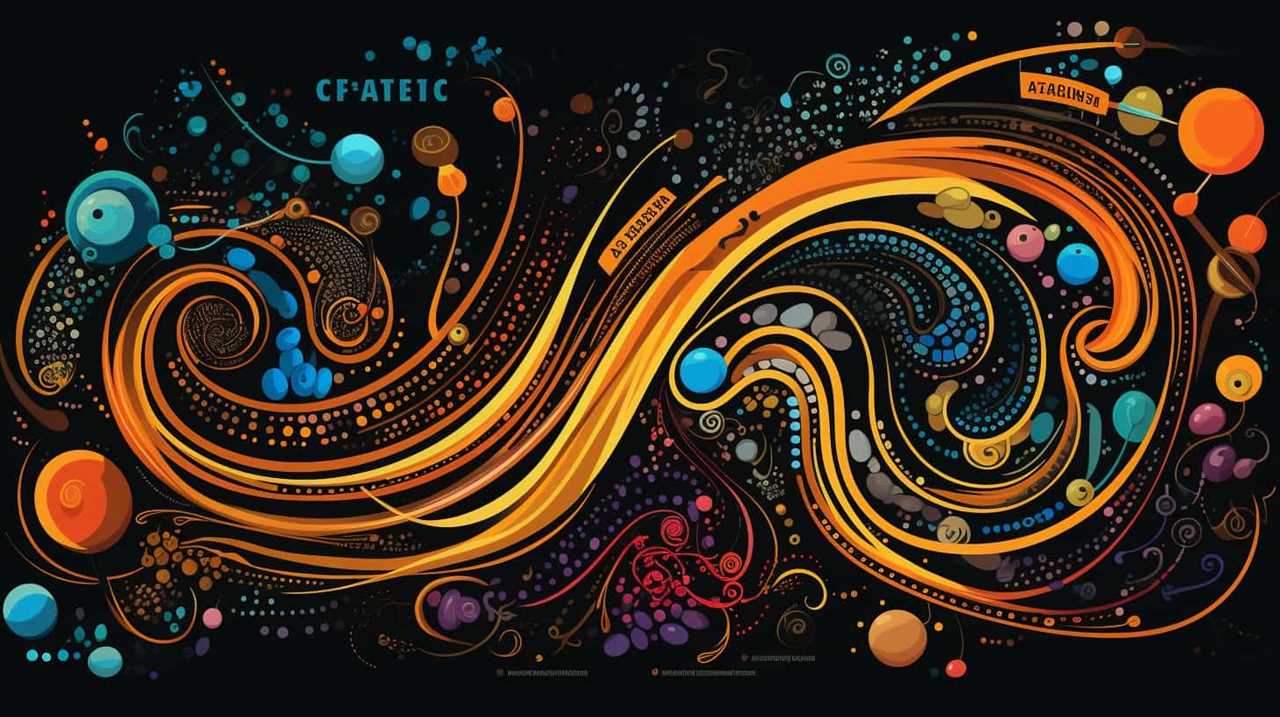
Exploring the Tree-Surfing Lifestyle
Let’s delve into the exciting world of tree-surfing and discover the thrill it offers to adventure enthusiasts.
Tree surfing is a unique outdoor activity that combines elements of zip-lining and obstacle courses, allowing participants to navigate through a series of platforms suspended high up in the trees.
To fully enjoy the tree-surfing experience, it’s important to learn and master certain techniques. These include maintaining a steady balance, using proper handholds, and controlling your speed and direction.
Tree surfing destinations can be found in various parts of the world, offering breathtaking views and challenging courses. Popular tree surfing destinations include Costa Rica, Australia, and Hawaii.

Whether you’re a beginner or an experienced adventurer, tree surfing is a thrilling way to connect with nature and push your limits.
The Americano Surfer Dude’s Connection With Nature
One of the things we love about the Americano surfer dude is their deep connection with nature. They’ve a remarkable ability to forge a bond with wildlife, making them true stewards of the environment.
Here are three ways the Americano surfer dude demonstrates their commitment to both connection with wildlife and environmental conservation efforts:
-
Respect for marine life: The Americano surfer dude understands the importance of protecting the oceans and its inhabitants. They actively participate in beach clean-ups and promote sustainable fishing practices.

-
Conservation awareness: These surfers are well-informed about the environmental challenges our planet faces. They support conservation organizations and raise awareness about issues such as habitat destruction and climate change.
-
Sustainable lifestyle choices: From using eco-friendly surfboards made from recycled materials to embracing a plant-based diet, the Americano surfer dude takes conscious actions to reduce their carbon footprint and minimize their impact on the environment.
The Americano surfer dude’s connection with nature goes beyond riding waves; it’s a holistic approach that inspires others to protect and preserve our natural world.
Unveiling the Secrets of the Americano Surfer Dude’s Tree Dwelling
We’ve always been curious about how the Americano surfer dude manages to create their tree dwelling paradise. Uncovering tree surfing techniques reveals that these individuals utilize a combination of engineering skills, environmental awareness, and creativity.

They carefully select sturdy trees with strong limbs and use ropes and harnesses to secure their platforms. The construction process involves building platforms, hammocks, and even makeshift showers. These tree dwellings serve as a haven for the Americano surfer dude, allowing them to connect with nature on a deeper level.
But tree surfing goes beyond just a place to live – it holds cultural significance for these individuals. It represents a way of life that embraces simplicity, freedom, and harmony with the natural world. The tree dwellings symbolize their desire to escape the confines of modern society and live in harmony with the earth.
The Impact of the Americano Surfer Dude on the Surfing Community
The Americano surfer dude has had a significant impact on the surfing community, fostering a sense of camaraderie and inspiring a new generation of wave riders. Here are three ways in which the Americano surfer dude has influenced the surfing community:
-
Influence on Fashion: The Americano surfer dude’s laid-back and carefree style has had a major influence on surfing fashion. From board shorts and graphic tees to trucker hats and flip flops, his relaxed and effortlessly cool look has become synonymous with the surfing culture.
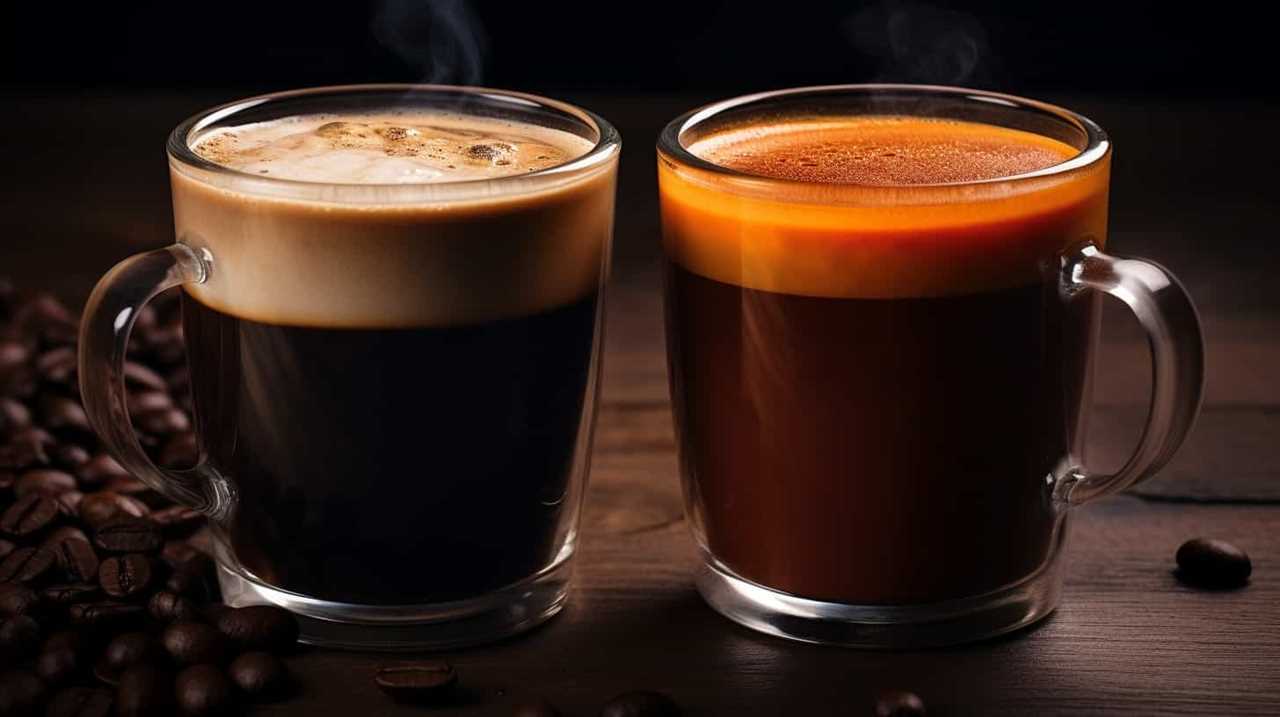
-
Controversy Surrounding Lifestyle: While the Americano surfer dude’s lifestyle is often romanticized, it has also faced its fair share of controversy. Critics argue that his carefree attitude towards responsibilities and commitment can lead to a lack of accountability and a disregard for societal norms.
-
Inspiring a New Generation: The Americano surfer dude’s passion for the ocean and adventurous spirit has inspired a new generation of wave riders. Many young surfers look up to him as a role model, embracing his love for the sport and his laid-back approach to life.
Frequently Asked Questions
How Did the Americano Surfer Dude’s Tree-Surfing Lifestyle Become Popular?
The rise of tree surfing culture can be attributed to the influence of the Americano surfer dude. His daring and unconventional approach to wave riding inspired others to seek new thrills and connect with nature in unique ways.
What Are Some of the Challenges Faced by the Americano Surfer Dude While Living in Trees?
Living conditions and safety measures are among the challenges faced by us while living in trees. We have to adapt to the natural environment, ensure stable platforms, and take precautions to prevent accidents.
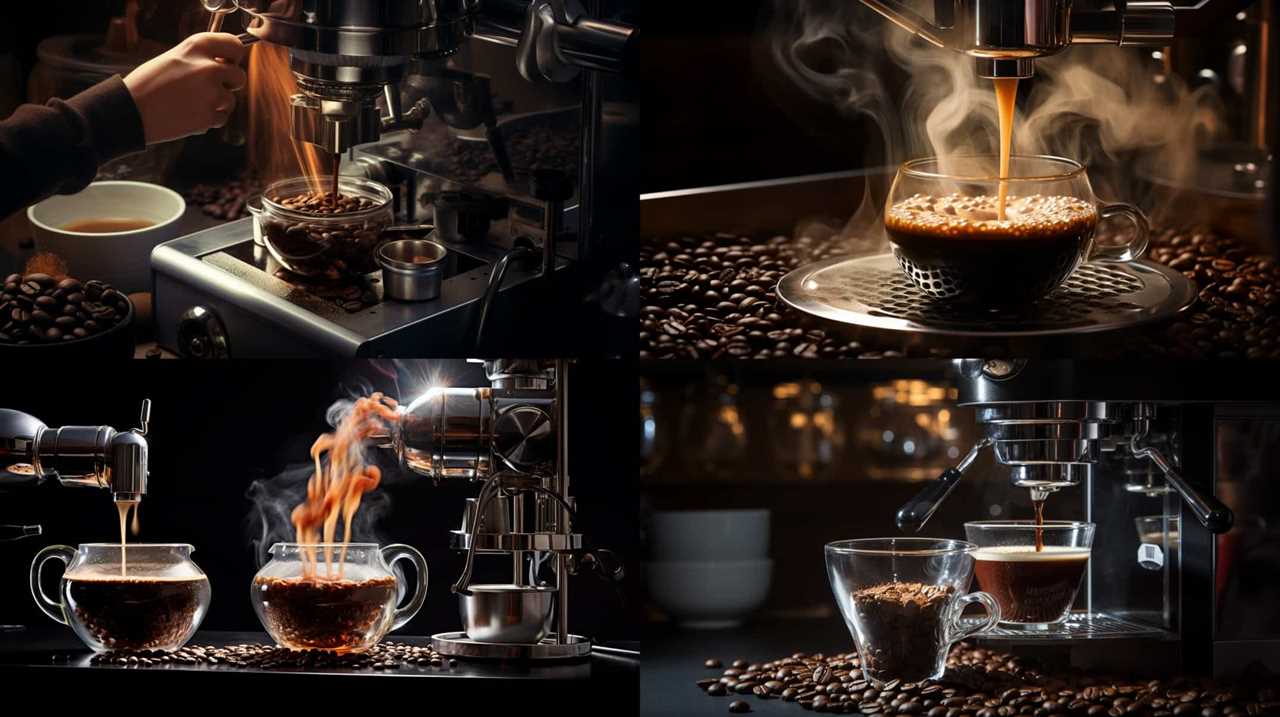
How Does the Americano Surfer Dude’s Connection With Nature Influence Their Overall Lifestyle?
Our connection with nature as Americano surfer dudes greatly influences our overall lifestyle. It brings us peace, harmony, and a deep appreciation for the environment. It shapes our choices, activities, and mindset, creating a fulfilling and sustainable way of life.
Are There Any Specific Techniques or Tricks That the Americano Surfer Dude Uses While Tree-Surfing?
When it comes to tree surfing, the Americano surfer dude has a bag of specific techniques and tricks up their sleeve. From mastering balance to navigating branches, they know how to ride those treetop waves with style and finesse.
What Changes Has the Americano Surfer Dude Brought to the Surfing Community in Terms of Style and Innovation?
Style evolution and impact on surf culture are two key aspects brought by the Americano surfer dude. His innovative techniques and tricks have pushed the boundaries, inspiring a new generation of surfers to explore new heights and embrace a unique style.
Conclusion
In conclusion, the Americano surfer dude’s choice to live in trees is truly baffling. While they may claim it connects them with nature, one can’t help but wonder if they’ve taken their love for the ocean a bit too far.

Despite their unconventional lifestyle, the impact of these tree-surfing enthusiasts on the surfing community can’t be denied.
So next time you spot an Americano surfer dude up in the trees, just shake your head and appreciate their unique and ironic approach to riding the waves.
In the vast and diverse world of coffee, coffee alternatives, and tea, Olivia has found her calling. As an author and a dedicated coffee and tea aficionado, her work for Cappuccino Oracle reflects her profound love and understanding of the intricate complexities found within these beverages. Olivia’s passion for the subject serves as both a catalyst for her creativity and a connection point with her audience.
Olivia’s appreciation for coffee, coffee alternatives, and tea blossomed at an early age. She discovered that these beverages invigorated her senses and stimulated her creative spirit. From the nuanced flavors of single-origin roasts to the captivating narratives intertwined with coffee, coffee alternatives, and tea trade and culture, Olivia found an unlimited source of inspiration in her daily cup.
Her love for these beverages and her talent for storytelling eventually converged at Cappuccino Oracle. As an author, Olivia’s mission is to illuminate the intricate tapestry that makes up the world of coffee, coffee alternatives, and tea. Her articles span a diverse range of topics, encompassing everything from the unique flavors of different brews to the sociocultural history intertwined with their cultivation and consumption.
Americano
How to Make an Iced Americano With Nespresso
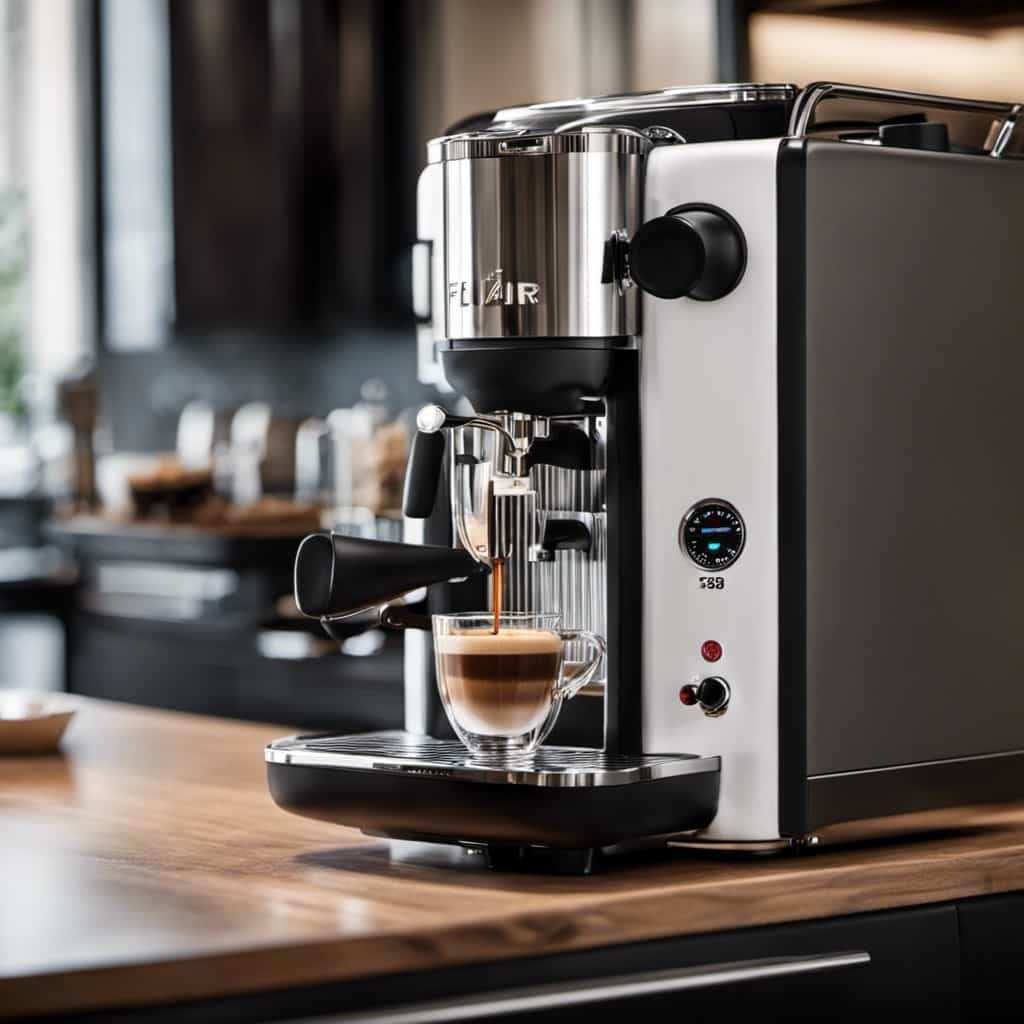
Do you have a hankering for a cool iced Americano to combat the summer heat?
Look no further! We’ve got the perfect recipe to satisfy your caffeine cravings.
In just a few simple steps, we’ll show you how to make an irresistible iced Americano using your trusty Nespresso machine.
With our expert guidance, you’ll be sipping on a cool and invigorating beverage in no time.

So, let’s get started and make your own café-worthy iced Americano at home!
Key Takeaways
- Consider the flavor profiles and caffeine strength of Nespresso capsules when choosing the right one for your iced Americano.
- Regularly clean and maintain your Nespresso machine, including descaling it every 3-6 months, to ensure optimal brewing.
- Choose the right Nespresso capsule for the espresso shot and follow the brewing process to extract a rich and flavorful espresso shot.
- Mix the espresso shot with cold water in a separate container to control the flavor and experiment with different ratios for variations.
Choosing the Right Nespresso Coffee Capsule
We’ll now discuss how to choose the right Nespresso coffee capsule for your iced Americano.
When it comes to selecting the perfect capsule, there are a few things to consider. First, let’s talk about the flavor profiles. Nespresso offers a wide range of flavors, from rich and intense to smooth and balanced. Each capsule has its own unique taste profile, so it’s important to choose one that suits your preferences.
Additionally, it’s helpful to weigh the pros and cons of each capsule. Some may have a stronger caffeine kick, while others may be more mellow. It all depends on what you’re looking for in your iced Americano experience.
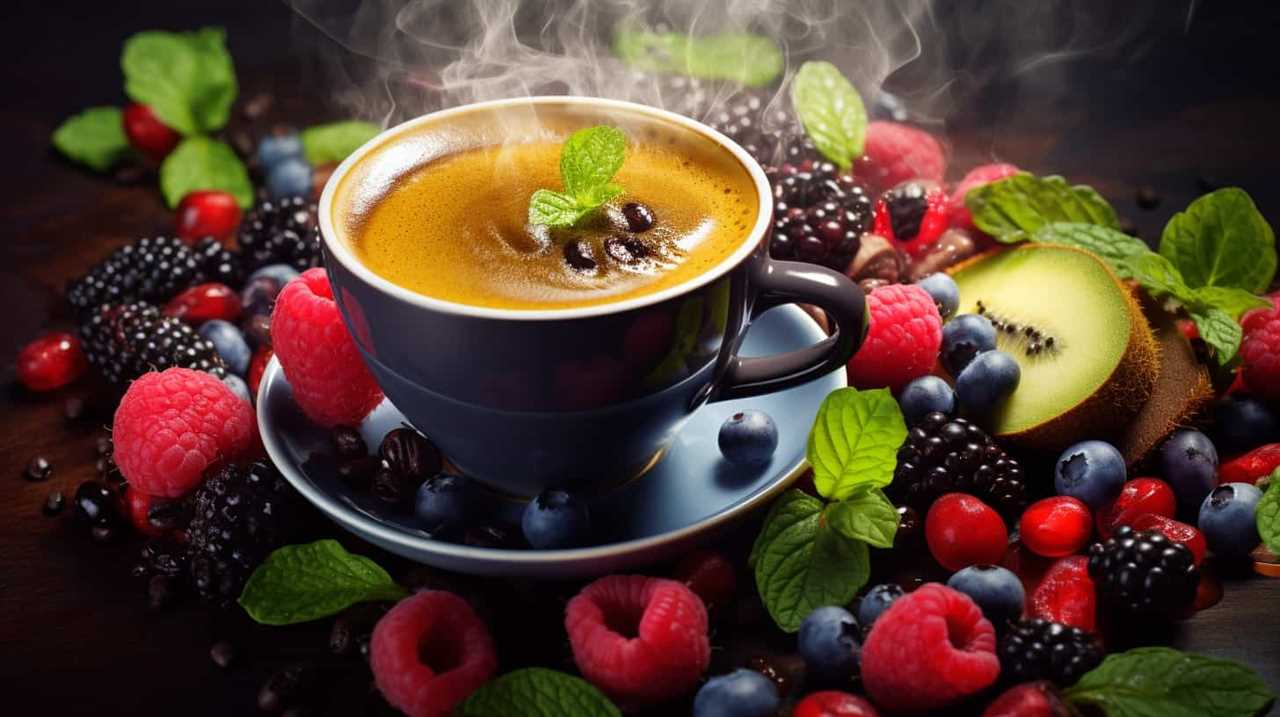
Now that we’ve discussed how to choose the right capsule, let’s move on to preparing your Nespresso machine for brewing.
Preparing Your Nespresso Machine for Brewing
Let’s get the Nespresso machine ready for brewing your perfect iced Americano. Before we start, it’s important to ensure that your machine is clean and functioning properly. Regular cleaning of your Nespresso machine is essential to maintain its performance and prolong its lifespan. Here are some key steps to follow when cleaning your machine:
| Cleaning Steps | Frequency |
|---|---|
| Descaling the machine | Every 3-6 months |
| Cleaning the drip tray and capsule container | Weekly |
| Wipe down the machine exterior | Regularly |
If you encounter any issues with your Nespresso machine, troubleshooting can help identify and resolve the problem. Common troubleshooting steps include checking the water tank, ensuring the machine is properly plugged in, and restarting the machine if necessary.
Now that your Nespresso machine is clean and ready to go, let’s move on to the next step: brewing the perfect espresso shot.

Brewing the Perfect Espresso Shot
To achieve the perfect espresso shot, we’ll need to select the right Nespresso capsule and ensure our machine is properly calibrated. Here are a few key steps to follow:
-
Choose the right Nespresso capsule: Each capsule has its own unique flavor profile, so selecting one that suits your taste preferences is crucial for extracting the best espresso flavors.
-
Calibrate your machine: Make sure your Nespresso machine is set to the recommended temperature and pressure settings. This will ensure that the espresso shot is extracted properly, resulting in a rich and flavorful cup of coffee.
-
Adjust the grind size: Depending on the Nespresso machine you have, you may have the option to adjust the grind size. Experiment with different settings to find the perfect balance between extraction time and flavor intensity.

Mixing Your Espresso Shot With Cold Water
After extracting the espresso shot, we simply mix it with cold water to create the refreshing iced Americano. This step is crucial in achieving the perfect balance of flavors and ensuring a smooth, chilled beverage.
When it comes to mixing techniques, there are a few variations you can try to suit your taste preferences.
One method is to pour the espresso shot over a glass filled with ice and then add the cold water. This technique allows the espresso to cool rapidly and prevents dilution.
Another approach is to mix the espresso shot and cold water in a separate container before pouring it over ice. This method allows for better control of the flavor intensity.
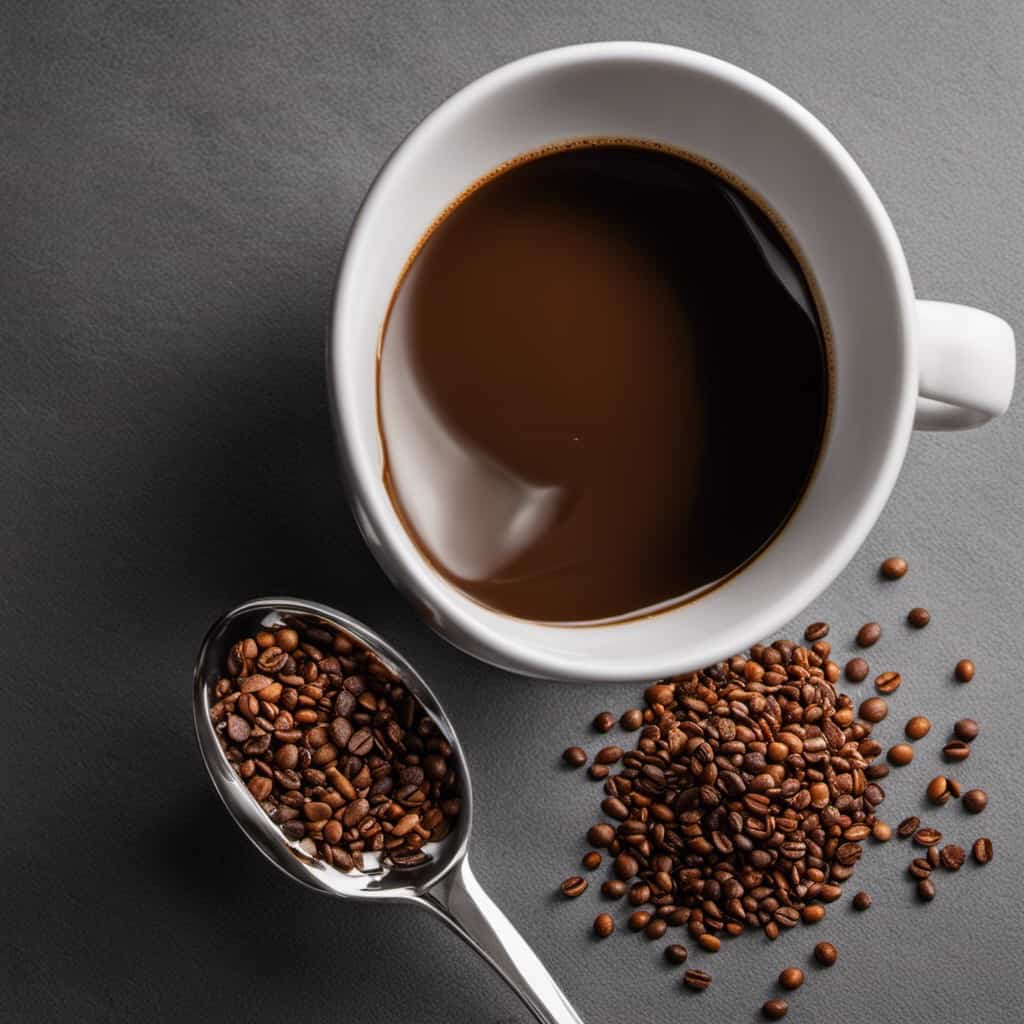
Flavor variations can also be achieved by adjusting the ratio of espresso to water. For a stronger flavor, use less water, and for a milder taste, add more water.
Don’t be afraid to experiment and find the perfect balance that suits your palate.
Adding Ice and Enjoying Your Iced Americano
With a glass filled with ice, we can now add our freshly mixed iced Americano and enjoy its refreshing flavors. The next step is to carefully pour the espresso shot over the ice, allowing it to cool down instantly. As the ice starts to melt, it further dilutes the coffee, creating a smooth and balanced drink.
Here are a few tips to enhance your iced Americano experience:

- Experiment with flavored syrups or extracts to add a touch of sweetness or a burst of flavor to your drink.
- Consider adding a splash of milk or cream to create a creamy and indulgent version of the classic iced Americano.
- Remember, the serving size for an iced Americano is typically 8 to 12 ounces, depending on personal preference and the strength of the coffee.
Now, take a sip of your homemade flavored iced Americano and let the coolness of the drink awaken your senses. Enjoy!
Frequently Asked Questions
How Long Does It Take to Brew an Espresso Shot With a Nespresso Machine?
To brew an espresso shot with a Nespresso machine, it takes about 25-30 seconds. Properly cleaning the machine and using the right coffee capsule are key for getting a perfect crema.
Can I Use Any Type of Coffee Capsule for Making an Iced Americano?
Yes, we have options when it comes to coffee capsules for making an iced Americano. There are alternatives to Nespresso capsules that can be used, providing a variety of flavors and choices.
What Is the Ideal Water-To-Espresso Ratio for a Perfect Iced Americano?
For a perfect iced americano, the ideal water-to-espresso ratio is crucial. It ensures the right balance of flavors. Additionally, using freshly brewed espresso is essential as it brings out the rich and vibrant taste.

Should I Add Sugar or Any Other Sweetener to My Iced Americano?
When making iced americanos, whether or not to add sweeteners is a matter of personal preference. Some people enjoy the added sweetness, while others prefer the pure taste of the coffee. It’s important to consider the pros and cons of using sweeteners.
Can I Use Flavored Syrups or Milk in My Iced Americano?
Yes, you can definitely use flavored syrups or milk in your iced Americano. Flavored syrups add a burst of taste, while flavored milk can create a creamy texture. It all depends on your personal preference!
Conclusion
In a refreshing twist, making an iced americano with Nespresso is as easy as a summer breeze.
By choosing the right coffee capsule, preparing your Nespresso machine, brewing a perfect shot of espresso, mixing it with cold water, adding ice, and indulging in the delightful concoction, you’ll be savoring the cool and invigorating flavors in no time.

So, go ahead and embark on this caffeinated adventure, where every sip is an escape to coffee paradise.
In the vast and diverse world of coffee, coffee alternatives, and tea, Olivia has found her calling. As an author and a dedicated coffee and tea aficionado, her work for Cappuccino Oracle reflects her profound love and understanding of the intricate complexities found within these beverages. Olivia’s passion for the subject serves as both a catalyst for her creativity and a connection point with her audience.
Olivia’s appreciation for coffee, coffee alternatives, and tea blossomed at an early age. She discovered that these beverages invigorated her senses and stimulated her creative spirit. From the nuanced flavors of single-origin roasts to the captivating narratives intertwined with coffee, coffee alternatives, and tea trade and culture, Olivia found an unlimited source of inspiration in her daily cup.
Her love for these beverages and her talent for storytelling eventually converged at Cappuccino Oracle. As an author, Olivia’s mission is to illuminate the intricate tapestry that makes up the world of coffee, coffee alternatives, and tea. Her articles span a diverse range of topics, encompassing everything from the unique flavors of different brews to the sociocultural history intertwined with their cultivation and consumption.
-

 Americano4 weeks ago
Americano4 weeks agoHow to Make Americano With Moka Pot
-

 Americano2 weeks ago
Americano2 weeks agoHow to Make Korean Iced Americano
-

 Americano4 weeks ago
Americano4 weeks agoHow to Make Americano With Bialetti
-

 Americano4 weeks ago
Americano4 weeks agoHow to Make Dutch Bros Americano
-

 Americano1 week ago
Americano1 week agoHow to Make an Iced Americano With Nespresso
-

 Americano3 weeks ago
Americano3 weeks agoHow Many Shots of Espresso for 16 Oz Americano
-

 Americano4 weeks ago
Americano4 weeks agoHow to Make a Hazelnut Americano
-

 Turmeric Tea2 weeks ago
Turmeric Tea2 weeks agoTurmeric Saffron Tea

















